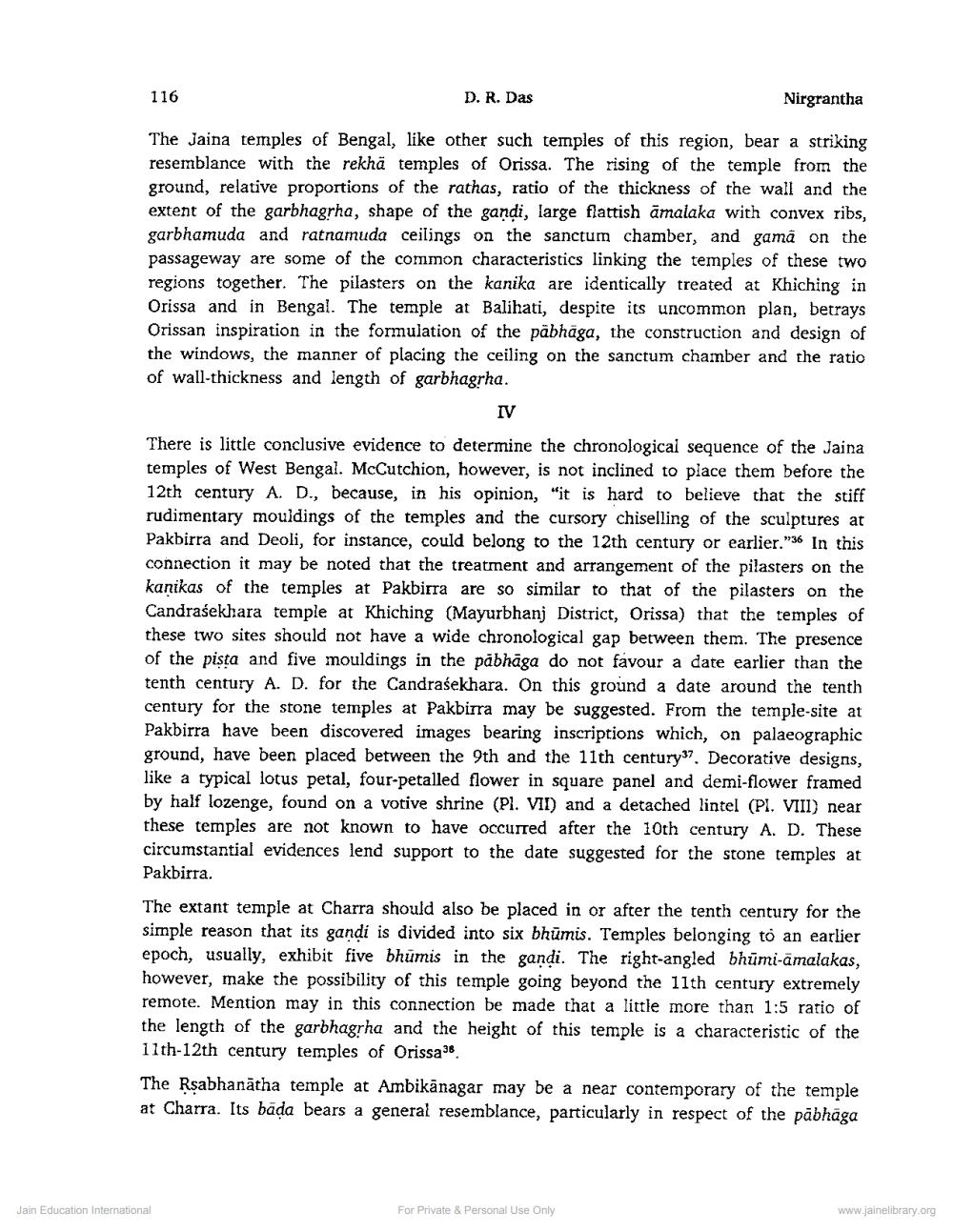________________
116
D. R. Das
Nirgrantha
The Jaina temples of Bengal, like other such temples of this region, bear a striking resemblance with the rekhä temples of Orissa. The rising of the temple from the ground, relative proportions of the rathas, ratio of the thickness of the wall and the extent of the garbhagrha, shape of the gandi, large flattish amalaka with convex ribs, garbhamuda and ratnamuda ceilings on the sanctum chamber, and gamä on the passageway are some of the common characteristics linking the temples of these two regions together. The pilasters on the kanika are identically treated at Khiching in Orissa and in Bengal. The temple at Balihati, despite its uncommon plan, betrays Orissan inspiration in the formulation of the päbhāga, the construction and design of the windows, the manner of placing the ceiling on the sanctum chamber and the ratio of wall-thickness and length of garbhagrha.
IV
There is little conclusive evidence to determine the chronological sequence of the Jaina temples of West Bengal. McCutchion, however, is not inclined to place them before the 12th century A. D., because, in his opinion, "it is hard to believe that the stiff rudimentary mouldings of the temples and the cursory chiselling of the sculptures at Pakbirra and Deoli, for instance, could belong to the 12th century or earlier."36 In this connection it may be noted that the treatment and arrangement of the pilasters on the kanikas of the temples at Pakbirra are so similar to that of the pilasters on the Candrasekhara temple at Khiching (Mayurbhanj District, Orissa) that the temples of these two sites should not have a wide chronological gap between them. The presence of the pista and five mouldings in the păbhāga do not favour a date earlier than the tenth century A. D. for the Candrasekhara. On this ground a date around the tenth century for the stone temples at Pakbirra may be suggested. From the temple-site at Pakbirra have been discovered images bearing inscriptions which, on palaeographic ground, have been placed between the 9th and the 11th century37. Decorative designs, like a typical lotus petal, four-petalled flower in square panel and demi-flower framed by half lozenge, found on a votive shrine (Pl. VII) and a detached lintel (PI. VIII) near these temples are not known to have occurred after the 10th century A. D. These circumstantial evidences lend support to the date suggested for the stone temples at Pakbirra. The extant temple at Charra should also be placed in or after the tenth century for the simple reason that its gandi is divided into six bhūmis. Temples belonging to an earlier epoch, usually, exhibit five bhūmis in the gandi. The right-angled bhūmi-amalakas, however, make the possibility of this temple going beyond the 11th century extremely remote. Mention may in this connection be made that a little more than 1:5 ratio of the length of the garbhagyha and the height of this temple is a characteristic of the 17th-12th century temples of Orissa
The Rsabhanātha temple at Ambikānagar may be a near contemporary of the temple at Charra. Its bada bears a general resemblance, particularly in respect of the pābhāga
Jain Education International
For Private & Personal Use Only
www.jainelibrary.org




